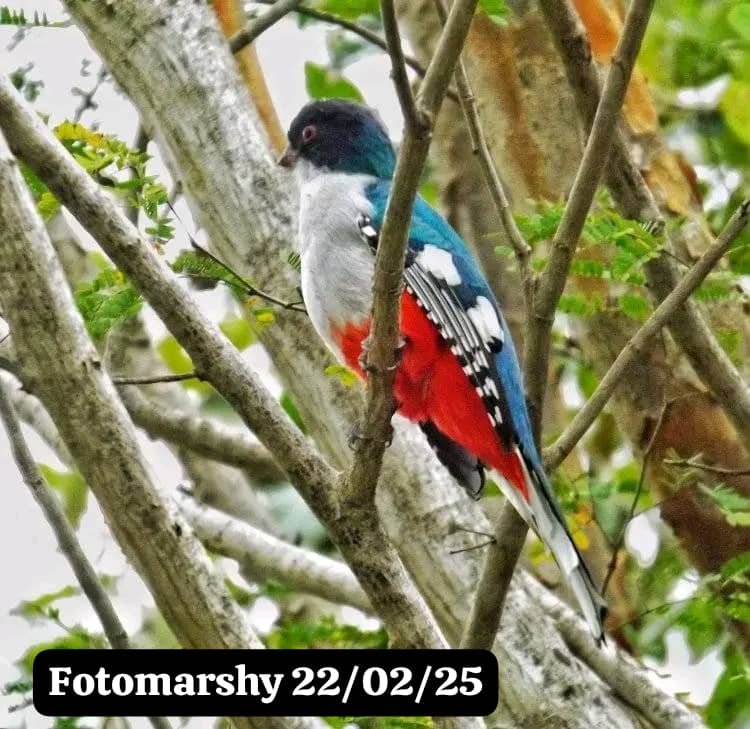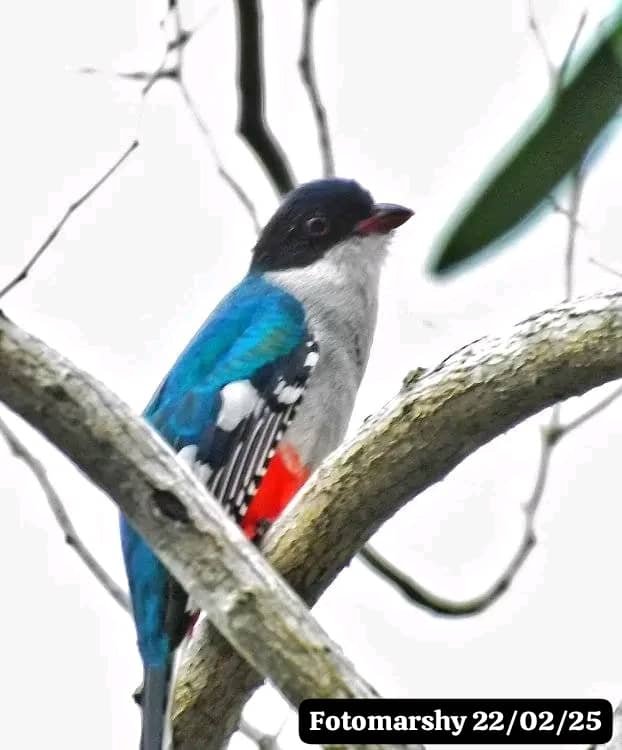National Bird of Cuba

Many times, we dream of finding a bird that seems elusive, but it turns out that the birds find us instead. It wasn't exactly the one I was looking for yesterday, but what a wonderful surprise it was when, while photographing a Cartacuba, I noticed a branch moving abruptly. When I looked over, there was our National Bird, the Tocororo, perched calmly right in front of me. It was a lifer for me, and despite the uncooperative weather with its clouds and intermittent drizzle, I managed to capture its presence. But that wasn't all; another specimen appeared later—it truly was my day.
Tocororo / Cuban Trogon / Priotelus temnurus.
El Yayal, Holguín, February 22
National Bird of Cuba
The Tocororo is chosen as the National Bird of Cuba for two reasons: its splendid plumage of vibrant colors and its resistance to captivity. It is considered the most beautiful bird in the country, as part of its green feathers resemble the Cuban fields; its white-breasted plumage, red belly, and blue head feathers reflect the colors of the national flag. There are two slightly different forms: one that lives on the Island of Cuba and adjacent keys (P. temnurus temnurus), and another that lives on the Isle of Youth (P. temnurus vescus). Its scientific name is Priotelus temnurus, belonging to the order Trogoniformes and the family Trogodinae. It is the only member of this family on the island, which also includes the Quetzal, the national bird of Guatemala. The indigenous Cubans call it "guatiní," a name still used in some eastern provinces. In English, it is known as the Cuban Trogon.

The male Tocororo measures about 28 cm in length, with a wingspan of 39 to 39.5 cm. The tail measures approximately 14.3 to 14.8 cm, while the female has a tail length exceeding this by half a centimeter. Additionally, females have slightly larger tails and wingspans by several millimeters. Aside from this, the pair does not exhibit sexual dimorphism. They also take turns incubating eggs and feeding their hatchlings.
Not known for great mobility, it often rests for long periods with its neck tucked in. It remains in this position, seemingly entranced by the landscape, only leaving to seek food. At that moment, its movements are quick and precise but limited to very short distances. It can be easily spotted in dense forests with tall trees of various species, such as the soplillo, almácigo, and yagruma. It is a peaceful bird that allows us to approach without fleeing.
It nests from April to July in holes left by abandoned woodpecker nests. The female lays 3 or 4 eggs, and both sexes incubate and feed their chicks.

Habitat
It has inhabited fields for thousands of years and is primarily found in the Sierra de los Órganos, Ciénaga de Zapata, Escambray mountains, Sierra Maestra complex, and Isle of Youth. It has rarely been bred in captivity; its freedom is vital for survival. It prefers forests of all types, including pine forests. The eastern mountains likely harbor thousands of Tocororos. In the Ciénaga de Zapata and the mountain ranges of Pinar del Río in central and western Cuba, their distinctive "to-co-ro-ro, to-co-ro-ro" can be heard echoing through the air.
Diet
It feeds on insects, fruits, and flowers that it catches while in flight.
Protection
As a species of wildlife, hunting or capturing the Tocororo is prohibited under Resolution No. 81 of 1982 issued by the Ministry of Agriculture, and there is legal protection against those who harm the Tocororo. This is established under Decree-Law 200 dated December 22, 1999, which outlines environmental violations.
Congratulations @marshy05! You have completed the following achievement on the Hive blockchain And have been rewarded with New badge(s)
Your next target is to reach 20 posts.
You can view your badges on your board and compare yourself to others in the Ranking
If you no longer want to receive notifications, reply to this comment with the word
STOPCheck out our last posts: